Issue:March 2022
SPECIAL FEATURE - Solubility & Bioavailability: Utilizing Enabling Technologies
“The biggest impediment in addressing bioavailability issues likely lies with a lack of deep familiarity with enabling technologies,” says Dr. Masumi Dave, Application Laboratory Manager, Pharmaceutical Division, Gattefossé USA. “Improving drug bioavailability begins with a thorough evaluation of the API’s physical and chemical properties in relation to solubilization in the dose, but more importantly its dissolution in vivo at the site of absorption.”
These technologies, such as nanoparticles, cocrystals, computer-aided prodrug design, and electrospinning, represent innovations aimed at enhancing the solubility of a candidate molecule, particularly in the gastrointestinal tract. “Technologies such as electrospinning, deep eutectic solvents, and ionic liquids are upcoming formulation approaches to enhance drug solubility, and as the science matures, and the relative strengths and weaknesses are better understood, we expect to see further application of these innovative approaches,” says Nathan Bennette, Director, Scientific Advisory, Catalent. “They have shown to be successful for some compounds, and have a place alongside other bioavailability enhancement technologies, where each strategy has its benefits and corresponding liabilities. For them to be successful and widely adopted however, they will also have to provide a compelling benefit compared with other well-understood, and commercially precedented technologies, such as amorphous solid dispersions and lipid-based formulations.”
In fact, according to Dr. Jessica Mueller-Albers, Strategic Marketing Director Oral Drug Delivery Solutions, Evonik Health Care, extreme compounds require either significant amounts of stabilizers to maintain the amorphous state or they are not amenable to common manufacturing technologies with reasonable cost of goods due to their low solubility in organic solvents. These include amorphous solid dispersions using polymethacrylate, cellulose, or povidone-based polymeric carriers, she says. In addition, thermostability of new molecular entities becomes an issue as most new molecules have melting points well above 400°F. Alternative production methods for amorphous solid dispersions can address these issues.
In this annual Drug Development & Delivery report, interviewees describe how they are using technologies such as lipid nanoparticles to achieve a high drug loading, combining anti-solvent continuous crystallization with micro-mixing technology to control crystallization and reduce crystal size, and robotic capsules to improve bioavailability in the range of 47% to 78%.
Ascendia Pharmaceuticals, Inc.: A Tailored Approach to Nanotechnologies
It is very challenging to improve solubility and bioavailability of a BCS II or IV API with a high melting point and a low solubility in a broad range of solvents. A high melting point makes it unfeasible to use hot melt extrusion to prepare amorphous solid dispersion, whereas low solvent solubility makes it challenging to spray dry or solubilize the compound in carriers. In some cases, these types of compounds can be nanosized by nanomilling, micro-fluidization or formulated into nano-emulsion or nanoparticles with an aid of a cocktail solubilizer combinations.
“Nanosuspension prepared by a top-down process such as nanomilling or high-pressure homogenization, amorphous nanoparticles by a bottom-up process or a combination of bottom-up and top-down process, and lipid nanoparticles utilizing lipid carrier, have been routinely used in Ascendia’s labs, attaining good results in achieving formulation with high drug loading and good bioavailability,” says Jim Huang, PhD, Founder and CEO of Ascendia Pharmaceuticals, Inc. “A tailored approach based on compound properties will always increase the chance of success using available nanotechnologies.”
For example, a BCS II compound (a high melting point and poor solubility in a range of solvents) was presented to Ascendia with a request to formulate and manufacture cGMP CTM for a Phase I study in a six-month window. Dr. Huang explains that Ascendia was able to formulate the compound with lipid nanoparticle technology for an oral route of administration, utilizing a combination of lipid and solubilizer to achieve a synergetic effect in solubilizing the compound. On the other hand, for an IV dosage form, by leveraging Ascendia’s in-house capability in aseptic nano-milling and microfluidization technologies, a sterile nanosuspension formulation was developed to achieve a high drug loading that enabled toxicology and Phase I dose range studies.
Catalent: The Root Cause of Bioavailability
Solubility-limited absorption remains a key challenge in terms of bioavailability for a large number of compounds looking to progress from the discovery phase towards the clinic. Increasingly, these molecules also exhibit high melting points and poor organic solubility, making these so-called “brick dust” compounds extremely difficult to process using conventional solubility-enhancing methods such as hot melt extrusion (HME) or spray drying. Alternative solubility-enhancing technologies, alongside innovations in the HME and spray drying processes, may be required to enable the development of such challenging solubility-limited compounds.
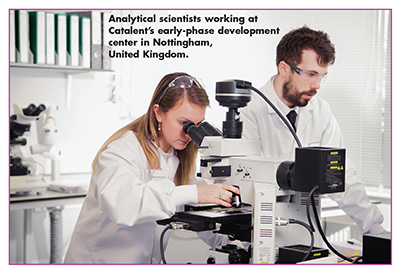
“Additionally, we are seeing a significant increase in the number of compounds that are beyond Lipinski’s rule of five (bRo5) where bioavailability is limited by permeability through the intestinal epithelium,” says Nathan Bennette, Director, Scientific Advisory, Catalent. There are presently very few options for formulating and delivering permeation-limited molecules, and the success of programs for drugs with these properties will depend upon the development of new tools and approaches for enabling their bioavailability.”
To successfully address a bioavailability issue, it is critical to first understand the pharmacokinetics of a molecule and evaluate whether bioavailability is limited by poor absorption, a physiological process (e.g., efflux or metabolism), or a combination of the two. If poor absorption is the root cause, it is important to distinguish between an inadequate dissolution rate, low aqueous solubility, and poor permeability, and each of these physiological and physicochemical conditions will require a different formulation approach. For example, where metabolism is the key issue, it is sometimes possible to design formulations that target pre-gastric absorption or enhance lymphatic absorption, both of which bypass first-pass metabolism by the liver. Particle size reduction and amorphous dispersions are well-precedented strategies for addressing slow dissolution or poor aqueous solubility, respectively.
“Early application of physiologically- based pharmacokinetic modeling can provide significant insight and guidance, so that formulation strategies can be focused on developing solutions to the actual challenges of bioavailability enhancement,” says Mr. Bennette.
CycloLab Ltd.: Electrospun Nanofiber Form vs. Lyopholized Remdesivir
Remdesivir, a monophosphoramidate prodrug, was discovered and developed by Gilead Sciences, Inc. It has been introduced as a promising new antiviral agent for the therapy against SARS-CoV-2 in the form of an intravenous product marketed under tradename Veklury®. Due to the poor aqueous solubility of remdesivir (0.028 mg/mL at room temperature), a need arose for solubility enhancement. CycloLab performed research to explore possibilities for electrostatic fiber drawing.
Dr. István Puskás, principal scientist with CycloLab, explains that this was attempted by employing different solubilizer excipients, such as surfactants, polymers, co-solvents and sulfobutylether-beta-cyclodextrin (SBECD). Twenty percent (w/w) aqueous solutions of Tween-80 provided 3.9 mg/mL dissolved remdesivir, PEG-400, dissolved 3.3 mg/mL, while SBECD at this concentration resulted in 8.5 mg/mL dissolved remdesivir.

The application of surfactants and polymers – despite their solubility-enhancing effect – was found inadequate for solubilizing enough active ingredient for a preferred formulation; the only satisfactory solubility enhancement was achieved by using SBECD. Currently, 13 FDA-approved injectable products are on the market that contain SBECD-solubilizing excipient and numerous clinical candidates are under development. Isolation of solid drug/SBECD complexes from common solution might be performed by various solvent removal techniques.To compare the performance of solid complexes prepared by two methods suitable for manufacturing injectable products, two types of formulations with identical composition were prepared and investigated by lyophilization and electrospinning, respectively. Common aqueous solutions of remdesivir and SBECD were prepared and filtered at room temperature. The resulting clear filtrates were processed by lyophilization and electrospinning into solid binary formulations. This study aimed at the comparison of wettability and dissolution properties of freeze-dried and electrospun nanofiber formulations of SBECD-enabled remdesivir compared to a mere physical mixture of the constituent powders (non-complexed form).
The CycloLab image demonstrates the differences of wettability, dissolution rate, and water solubility of the physical mixture of remdesivir and SBECD compared with those of the two complex formulations (lyophilized and electrospun samples). Dr. Puskás says the physical mixture did not dissolve completely, the partial dissolution of the composite powder could be attributed to the hydrophilic SBECD matrix. After 10 minutes measured from the addition of water (WFI), the lyophilized sample spontaneously dissolved. Full dissolution of the electrospun nanofibers was observed notably faster. The dissolution was completed in 5 minutes after contact with the dissolution medium. Significant differences were found in wettability and dissolution rates of formulations with identical average composition, indicating that solid-phase engineering and complexation with SBECD do matter.
“In conclusion, reconstitution and dissolution properties of an electrospun nanofiber form of remdesivir were found to outdo those of the lyophilized formulation having identical composition,” he says. “These superior wetting and dissolution properties of electrospun nanofiber offer the possibility to develop non-invasive, quickly absorbable dosage forms of a drug. Further studies are in progress to prove the feasibility of electrospun nanofiber made from SBECD-enabled remdesivir as a non-invasive therapeutic option.”
Enteris BioPharma: A Game Changer Transforms Treatments
With an increased number of “beyond rule of 5” (bRo5) compounds in clinical trials and some recent drug approvals by FDA in the oncology space, there is heightened interest among pharmaceutical companies to pursue drug development of these compounds. bRo5 compounds, such as peptides, peptidomimetics, and a growing number of intermediate-sized molecules, are traditionally considered undruggable for oral delivery due to low aqueous solubility, or poor permeability, and other challenges. The use of an external enabling technology for oral delivery of these compounds combined with a scalable manufacturing process can present a win-win situation for drug makers and patients by reducing time to drug launch, speeding up market entry, and improving patient compliance.
While most enabling technologies can improve solubility, the ability to develop oral tablet formulations that address both the permeation and solubility challenges represents a game changer for drug makers to enhance multiple drug products and transform entire treatment paradigms. Enteris’ ProPerma® and Peptelligence® platforms tackles both issues of solubilization and permeation using solubilizing agents that are also permeation enhancers,explains Dr. Rajiv Khosla, CEO of Enteris BioPharma. The Pro- Perma approach utilizes an enteric coating surrounding a tablet core containing the API, along with the enhancing excipients. By delivering the formulation directly to the highly absorptive area of the small intestine, such permeation enhancers enable the transport across the epithelium via diffusion through the tight junctions, or by the transcellular route, crossing the cell membrane. The technology employs granulated citric acid, which acts as a permeation enhancer that makes the tight junctions more porous and removes diffusion barriers. It also protonates basic drugs, adding positive charge, which increases water solubility. In addition, the formulation contains a surfactant, suitable for tablet manufacturing, to further increase solubility and permeation.
“The Enteris platform improves oral bioavailability through a combination of the pH-lowering and solubilizing effects of the formulation in a highly-scalable solid oral dosage form, without making modifications to the API,” he says.
The process for testing oral feasibility using the Enteris platform involves a transparent review of the physicochemical properties of the partner’s API to determine fit and compatibility with the technology, using a developability assessment. Given an appropriate fit and alignment with the partner’s goals, Enteris will then provide a plan to develop customized formulations containing enterically-coated tablet prototypes with the API to demonstrate proof-of-concept of oral bioavailability enhancement in nonclinical pharmacokinetic studies and ultimately human clinical trials.
As an example, Enteris recently worked with a partner to improve the bioavailability of a bRo5 compound with poor solubility and permeability. This compound had a molecular weight greater than 600 Da, with multiple H-bond acceptors, poor solubility at neutral pH, and poor permeation. Enteris’ proprietary oral solid dose formulation technology improved bioavailability of the API, showing pharmacokinetics similar to a lipid-based formulation but with the convenience of a solid oral dosage form.“Enteris’ technology provides a unique approach to addressing both solubility and permeation in a tablet formulation,” says Dr. Khosla.
Evonik Health Care: Optimized Compound Outcomes
Over the past few years, Dr. Jessica Mueller-Albers, Strategic Marketing Director Oral Drug Delivery Solutions, Evonik Health Care, has observed that one of the most common customer challenges is creating a development strategy for preclinical toxicology and first-in-human studies for poorly soluble drugs. “Small molecules are continuing to become more complex so that more sophisticated formulation strategies are required,” she says. “Usually, the major challenges, however, revolve around limited budget and limited amounts of API. At the same time, the number of accelerated approvals from the FDA with Fast Track and Breakthrough designations on low solubility compounds is increasing. This is especially true for oncology programs that show promising early-stage results and may have reduced clinical study requirements.”
Miniaturized screening tools have been developed to support the design of the best formulation. But it is not only the formulation that has a strong influence on the pharmacokinetic profile and later performance of the drug product, she notes. The choice of the process technology is also key and can change during the development program when transitioning from early to later stages. Therefore, a seamless transition from drug discovery to preclinical toxicology to clinics and commercial manufacturing is still a hurdle for many programs. “All formulation and process development activities must have a strong sense of scalability early on to ensure this seamless transition and realize right-first-time formulation,” she says.
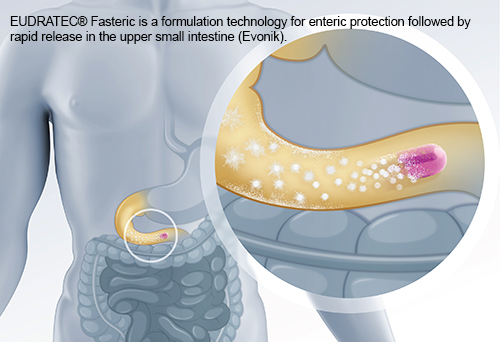
Pharmaceutical companies are looking for partnerships during the early phase of development to gain access to the newest and most innovative solutions and technologies. These are not limited to solubility-increasing solutions, but also focus on optimized targeting and delivery outcomes for the compound. One example of these new technologies is EUDRATEC® Fasteric, a bilayer formulation technology for enteric protection followed by rapid release in the proximal region of the small intestine, the duodenum. Several drugs require the release in the duodenum to avoid exposure to P-glycoprotein transporter, which increases towards the distal region of the intestine. EUDRATEC Fasteric can rapidly release 90% of the drug within 30 minutes of arrival at a specific, pre-defined pH level between 3.0 and 5.5 to precisely match the release profile requirements of APIs, which have a narrow absorption window. The formulation technology is suitable for use with a range of oral dosage forms, including multiparticulates, tablets, and capsules.
Gattefossé USA: Lipid-Based Excipients in Your Toolbox
Every formulation technology has its unique set of advantages and shortcomings. Salt formation or prodrug design approaches, for example, necessitate medicinal chemists to go back to the drawing board, starting anew. Nanoparticles offer some interesting advantages that may address some but not all the challenges presented by any given API. Solid dispersions have their own limitations in terms of drug stabilization and development time. Most importantly many of these techniques are appropriate for late-stage formulation optimization and are inadequate for early preclinical handling of the API.
“However, lipid-based formulation technologies, notably SEDDS/ SMEDDS for oral delivery or microemulsions for dermal/transdermal delivery, can be used as early as preclinical phases and carried throughout the development process,” says Dr. Masumi Dave, Application Laboratory Manager, Pharmaceutical Division, Gattefossé USA. “The lipid approach can help solubilization, dissolution in vivo, and improve absorption, notably by mitigation of the food effect. Our extensive work confirms that lipid-based excipients should be in the formulation toolbox to be considered from early- to late-stage formulation with no hiccups in the process.”
For a customer project, Gattefossé worked on a BCS Class II API that was initially developed as an injectable formulation. However, due to complications involving sterilization of the API, the customer wanted to target an oral solid dosage form. After solubility screening studies, Gelucire® 48/16, Labrasol® ALF, and Transcutol® HP were selected given their ability to solubilize the active at desired dosage levels, explains Dr. Dave. Gelucire 48/16 and Labrasol ALF are polyoxylglycerides with a high hydrophilic lipophilic balance (HLB) value and are widely used as solubilizers and bioavailability enhancers. Transcutol HP is the highest purity grade of diethylene glycol monoethyl ether used as a solubilizer and topical permeation enhancer.
The performance of the formulation was assessed by checking its dispersibility in aqueous media and its ability to maintain the API in solubilized form in vitro lipolysis testing. “This test is a great predictive tool to aid in screening formulations to be selected for clinical study,” she explains. “The formulation(s) with the ability to maintain the active in solubilized form throughout the test is selected for further evaluation in animal models. In the end, we were able to recommend formulations to the customer that should be selected for evaluation in animal models.”
Lubrizol Life Science Health: Polymers for IP-Protection & Lifecycle Management
While there are excipients and techniques available to address bioavailability and solubility, they often have low efficiency and lead to complex manufacturing processes or undesired side effects for patients, says Robert W. Lee, PhD, President of the CDMO Division of Lubrizol Life Science (LLS) Health. Additionally, a lack of patented excipient options makes it difficult to formulate viable 505(b)(2) products.
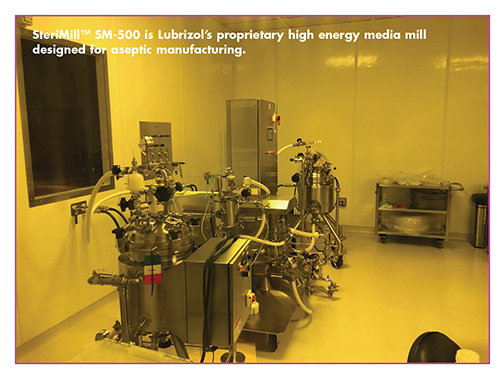
“IP-protected polymers and technologies not only solve difficult technical challenges, but they also incentivize companies to pursue re-formulation of existing APIs and bring new/improved options to patients,” he says. “There are many polymer chemistries being explored for solubility enhancement, but only a limited number have advanced beyond lab-scale into GMP manufacturing. To be a truly viable commercial option, excipients require investment in process scale-up as well as regulatory and quality oversight.”
LLS Health’s oral-grade Apinovex™ and injectable-grade Apisolex™ polymers were designed to overcome poor solubility using simple, scalable manufacturing techniques. Apinovex and Apisolex are excipient-grade polymers that offer IP-protection and lifecycle management for BCS Class II and IV APIs. Apinovex polymers are GMP-validated, high molecular weight polyacrylic acid excipients designed to provide both processing and formulation benefits for spray-dried amorphous solid dispersions (ASDs). Apinovex polymers enable formulators to achieve stable, high drug loading (up to 80%), and up to 10 times improvement in drug release for crystalline APIs. “With Apinovex, formulators can develop efficient, IP-protected oral solid dosage forms for a range of poorly soluble APIs,” says Dr. Lee.
The Apisolex polymer is an injectable-grade poly(amino acid)- based co-polymer that has been shown to increase the solubility of hydrophobic APIs by up to 50,000 times where other commonly-use excipients fail, he says. “Robustly patented, safe, efficient, and scalable, Apisolex formulations can achieve drug loading up to 40%, dramatically increase the achievable concentration of API in water, and reconstitute in saline in less than 30 seconds.”
In addition to these polymers, LLS Health routinely uses a variety of nanotechnology-based drug delivery technologies, including polymeric nanoparticles, solid lipid nanoparticles, nanoemulsions, and nanoparticulate suspensions (i.e., nanocrystals). “We frequently evaluate nanocrystals produced using a high energy media milling process (i.e., nanomilling) for water-insoluble APIs,” explains Dr. Lee. “We believe that Lubrizol does more nanomilling than most other CDMOs and since most of our programs are intended for parenteral administration, we would consider this to be a trend and a go-to technology for sterile products.”
When it comes to sterile products, most nanocrystal formulations are not amenable to terminal sterilization, so LLS Health offers aseptic nanomilling to its clients. Using its proprietary SteriMill™ Technology, Lubrizol can scale aseptic nanosuspensions up to and including commercial batches.
“Nanomilling is a scalable, proven technology and we can achieve concentrations up to 50% API,” Dr. Lee says. “This leads to a more efficient process requiring fewer unit operations to produce the final drug product. Nanomilling ultimately facilitates scale up and eventual commercialization for our clients.”
Micropore Technologies Inc.: Controlled Crystallization
One way to improve solubility is through the control of the crystallization process of APIs. During a recrystallization process, control over the size, size distribution, morphology, and crystallinity of the crystals can be difficult. API crystallization is directed by supersaturation and can result in size growth as the driving force, resulting in the formation of larger crystals. The rate of crystallization throughout the entire system can also be uneven and uncontrolled. This leads to a wide distribution of crystals of various sizes and morphologies. Crystallization also favors the formation of API crystals that are in a more structurally ordered crystalline state. Ordered crystalline API crystals (unlike amorphous particles) tend to have poor solubility, which can also lead to poor bioavailability during medical use.
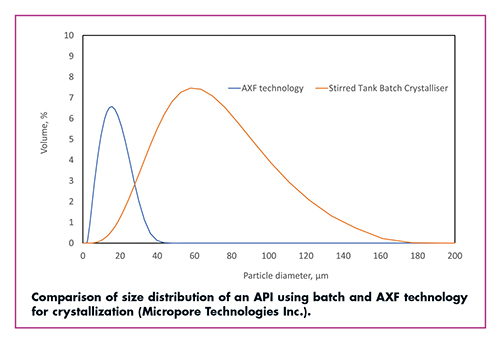
Micropore has combined reverse anti-solvent continuous crystallization with its micro-mixing technology, giving a highly (or exquisitely) controlled crystallization process and environment. “Through understanding the solubility of an API, we have found its controlled introduction to an anti-solvent can dictate the size, size distribution of the crystals, their morphology, and, critically for bioavailability, we could dial in the degree of crystallinity,” says Dr. Matthew Bennett, Crystallization Scientist, Micropore Technologies Inc. “We have worked with drugs of low solubility and bioavailability and have succeeded in obtaining small particle sizes in amorphous states. This breakthrough work will result in increased API solubility and bioavailability.”
One leading biopharmaceutical company approached Micropore for methods that reduced the size of crystals for one of its major APIs. Dr. Bennett explains that initial work involved replicating the company’s crystallization methods using Micropore’s advanced crossflow (AXF) technology. Further worked involved changing the overall formulation while also carrying out the crystallization through AXF technology. The results showed the crystal’s average size was reduced from 240μm to that of almost a tenth of the size at 26μm along with a smaller size distribution.
Quotient Sciences: Integrated Development Strategies Overcome Solubility Challenges
There is no one-size-fits-all solution for improving bioavailability and solubility, and what is correct for one molecule could be over-engineering, or worse, limiting the potential of another drug. It is therefore crucial for development teams to understand the drivers of a given molecule’s solubility and its permeability properties to select the correct technologies for assessment, and then back up that selection with data. “One of the biggest challenges we see is the expectation of an in vitro/in vivo correlation in developing these technologies, which is not realized when clinical data is obtained,” says John McDermott, Executive Drug Development Consultant, Quotient Sciences. “Having access to human data to assess formulation technologies for poorly soluble drugs is therefore crucial in guiding formulation selection and optimization.”
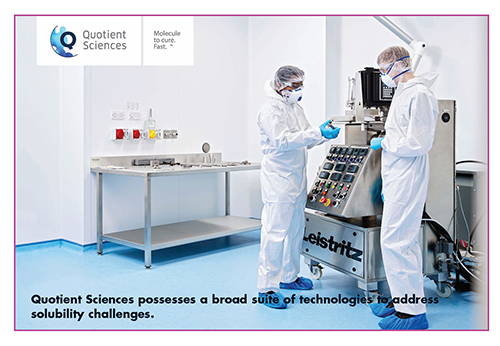
Quotient has had the opportunity to work on several programs that have assessed the clinical performance of some of these novel and emerging technologies to enhance drug bioavailability. “We have seen some great successes for some drugs, and we have also had experiences where performance observed in preclinical and in vitro studies have not translated into humans,” he says.
Quotient Sciences delivers fully integrated programs incorporating formulation development with clinical manufacturing, regulatory support, and clinical testing. This platform, termed Translational Pharmaceutics™, can be applied to accelerate the progression of prototype formulations to clinical assessment and onward, to efficiently and accurately assess candidate formulations, and to improve the likelihood of clinical and commercial success, explains Mr. McDermott.
In one recent case study, a customer with a BCS II molecule had completed its first-in-human study, which demonstrated inadequate exposure and a significant food effect. These issues were stalling the project from advancing into proof-of-concept patient studies. To respond to this, the client needed to rapidly evaluate solubility enhancement technologies and demonstrate its utility to enable efficacy assessments in order to proceed to the next project milestone.
In this program, Quotient Sciences developed three different solubility-enhancing formulations: a micronized form of API; a self-emulsified lipid delivery system; and a spray-dried dispersion. A Translational Pharmaceutics study was performed to achieve a quick proof-of-concept assessment, removing the need to conduct larger scale, cost-prohibitive process development and lengthy stability programs for multiple technologies. The human pharmacokinetic (PK) study used a 5 period cross-over design in 16 healthy volunteers with the micronized formulation delivering the best outcome.
“By applying our Translational Pharmaceutics approach, the overall timeline – from initiating formulation lab work to having clinical PK data to select the optimal formulation – was just six months,” says Mr. McDermott. “While it’s exciting to be involved at the forefront of research in drug delivery technologies, it’s important to remain focused on the patient – and the best model for assessing humans is a human.”
Pii: Creating Amorphous Material for Improved Bioavailability
The majority of new APIs are still poorly soluble in aqueous media and fall either under the BCS Class II or IV category. A drug molecule needs to be in a solution state to get across the intestinal membrane at enough concentration and rate to elicit the desired pharmacological effect. Hence, solubilization and permeability are prerequisites for good bioavailability. For a very poorly soluble drug with a limited option of formation of salts, co-crystals or prodrug, finding GRAS solvent/excipient combination that can solubilize the drug at sufficient concentration and prevent precipitation in the G.I. tract is a major hurdle to improving bioavailability, says Sundeep Sethia, PhD, Senior Director, Pharmaceutical R&D at Pharmaceutics International, Inc. (Pii).
Dr. Sethia describes how Pii helped improve bioavailability of a poorly soluble drug, in combination with solubilizer/excipients. This drug showed an incomplete and very slow release profile. The product needed to be developed as a tablet dosage form. As a result, the combination of drug and excipients were dissolved in a solvent and spray dried to provide amorphous material. Soluble drug material was hygroscopic and static with poor flow. The material was roller compacted with a binder and glidant to achieve compacted material milled to get acceptable flow properties. The milled material was then final blended with lubricant and compressed in the tablet dosage form. Precaution was taken to ensure humidity controls during processing, and desiccants were used for storage of finished product. “The amorphous API in the tablets showed faster and complete release that yielded desired PK profile and much improved bioavailability compared to the micronized API tablets,” said Dr. Sethia.
Rani Therapeutics: Robotic Capsules Enhance Injectables Bioavailability
The vast majority of biologic drugs have to be delivered through an injection or infusion. The main impediment to oral delivery of biologics has been the catabolic nature of enzymes in the gut, which are extremely efficient at digesting biological matter and absorbing it as nutrients. Biologics are also much larger in size and weight than small-molecule drugs, making permeation across the gut epithelium a challenge. Thus, when taken orally, most biologics have extremely poor absorption and low bioavailability.
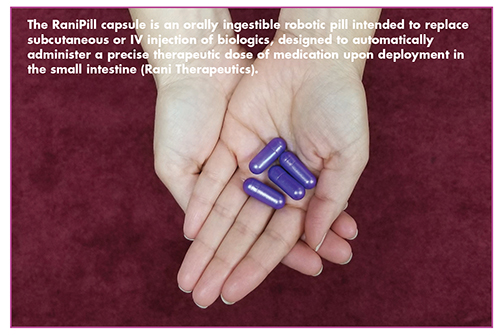
Many attempts have been made to deliver biologics orally, most of which have taken a chemistry-based approach involving permeation enhancers, protease inhibitors, or enteric-coated capsules, explains Talat Imran, CEO of Rani Therapeutics. These mechanisms are used to encapsulate or shield biologic drugs from the digestive action of gut enzymes and increase systemic uptake. However, even the successful attempts have shown bioavailability no greater than ~1%, he says. Robotic pills are another approach, which may combine several features for targeted delivery to the gut.
One example of a robotic pill having a successful outcome is in the case of octreotide, a synthetic hormone for the symptomatic treatment of acromegaly and carcinoid syndrome. Acromegaly in particular impacts 25,000 patients in the US each year, who require ongoing treatment for chronic symptoms. However, current treatment using octreotide involves painful subcutaneous injections administered three to four times daily or an extended-release formulation via painful, deep intramuscular injections every four weeks, and as many as 13% of patients cannot adhere to long-term therapy.
The majority of previous attempts to develop oral versions of biologics like octreotide were chemistry-based, and the best attempts have resulted in low bioavailability of certain peptides up to 1%. “Instead, we developed a robotic pill to deliver octreotide directly to the jejunum,” says Mr. Imran. The capsule has a protective enteric coating designed to withstand stomach acid and only dissolve in the small intestine. Once dissolved, intestinal fluids activate a self-inflating balloon, which deploys a microneedle containing octreotide to deliver the biologic into the highly vascularized wall of the small intestine, where it easily enters the bloodstream. “Bioavailability for our robotic capsule has been in the range of 47% to 78%.”
In a Phase I clinical trial of 62 healthy patients, bioavailability of octreotide delivered by oral robotic capsule was 65% relative to the IV group, confirmed in one or more hourly blood samples.
Seqens: A Toolbox of Strategies
Fine-tuning the molecular design of APIs is required to enhance binding selectivity for a biological target. It is now common to observe new drugs weighting more than 800 Da, with multiple stereocenters. Among other consequences, the drug solubility or permeability is often reduced, resulting in absorption issues, first pass metabolism, and elimination by the kidneys.
“Within the BCS classification, more than two-thirds of APIs present a bioavailability challenge –10% to 20% of them being classified as Class IV – suffering from both low solubility and permeability,” says Frédéric Schab, PhD, Drug Delivery Solutions Managing Director, Seqens. “Several strategies can be deployed to improve bioavailability, leveraging a wide range of scientific competencies.”
Reducing the particle size of APIs is one method to increase the surface area and improve the dissolution kinetics. Physical post-treatments, like milling or micronization, are commonly used tools, but more advanced technologies, such as cryomilling and nanomilling are deployed to treat more reluctant APIs, he says. One way to monitor the particle size is to control the granulometry during the crystal formation step. For instance, continuous crystallization (through plug flow tubular systems or continuous stirred-tank reactors) requires high process engineering know-how and can help to reach fine and tight particle size distribution, avoiding an extra production step.
A second approach consists of altering the API’s solid state form to improve the physico-chemical properties. “Pharmaceutical crystal engineering, with high-class analytical and screening tools, allows us to investigate alternative salt forms with various counter-ions, perform polymorph screening (metastable form, hydrates), or develop co-crystals to enhance the absorption performances,” explains Dr. Schab.
A third strategy consists of formulating drug with carefully selected excipients, such as polymers and lipids. These ingredients offer a level of customization potential, and open up enormous application potential, not limited to improving solubility. “Lipids recently marked a milestone in the medical field,” he says. “Due to their high biocompatibility and low immunogenicity, lipids are the most commonly used non-viral vectors for nucleic acid delivery required for gene therapy and DNA/mRNA vaccines.”
Bioresorbable polymers, such as PLA/PLGA or polycaprolactone, are used in controlled-release drug formulations for their ability to protect APIs from degradation, reduce the number of intakes, and liberate the drug over a long period of time. Other hydrosoluble polymers (polyethyleneglycol, polyethyleneimine, polyoxazoline, copolymers) are widely studied to encapsulate APIs or design API-polymer conjugate prodrugs.
“Remarkably, hybrid polymers and lipids excipients also constitute major research tracks for the development of new improved delivery systems,” says Dr. Schab.
Serán BioScience, LLC: Turning Technologies into Dosage Forms
Advances in human biology continues to identify novel druggable targets. These new targets create fundamental challenges for medicinal chemists. Many of these targets require novel drug properties, such as hydrophobicity in order to achieve sufficient binding efficiency and to avoid off-target interactions. Many of these new molecules are insoluble in water and have limited permeability in the small intestine. These new molecules can therefore exhibit very low bioavailability in both preclinical species and humans. This is a daunting problem to overcome for drug development.
New technologies enable sufficient bioavailability of these compounds; many of these technologies have been demonstrated at commercial scale. Examples include spray dried dispersions, nanomilling, and melt extrusion. Other approaches, such as salt forms and co-crystals are also applicable in many cases. With appropriate know-how and expertise, these technologies can be developed into various dosage forms, such as suspensions, capsules, and tablets.
Serán BioScience, LLC is a science-based CDMO that specializes in a variety of drug delivery and formulation approaches suited to optimizing bioavailability. Serán’s approach begins with a comprehensive review of the molecular properties of the drug and the client’s development goals to identify the preferred technical and development approach that can dramatically reduce time to the clinic and launch. Often, the development path begins with preclinical studies that require very high drug exposure (often 10-100 times greater than desired clinical exposure), explains Dan Smithey, PhD, CEO, Serán BioScience, LLC. This is a common challenge that requires engineered formulations to achieve consistent results in dose-escalation and toxicology studies. These formulations (suspensions) ideally consist of particles specifically engineered for these studies. Amorphous particles in suspension can provide exposure at high doses, but stabilizing these suspensions is critical to maintaining exposure. “Serán has unique approaches that enable stable suspensions of amorphous particles,” he says.
Serán has developed a multitude of spray dryers that are capable of manufacturing formulations that enhance bioavailability across a wide range of scales, from 100mg to 100kg. “All of our spray dryers have the ability to produce engineered particles using virtually any type of nozzle system, including pressure nozzles, 2-fluid nozzles, and ultra-sonic nozzles,” says Dr. Smithey. “This capability provides ultimate flexibility in formulation design to optimize exposure and downstream processability.”
In addition to particle engineering, the development of a solid dosage form is key to successfully improving bioavailability. Due to the unique nature of engineered particles that are developed to enable bioavailable formulations, solid dosage forms also need to be engineered to ensure the physical properties, performance, and stability of these particles is acceptable. Typically, dry granulation using roller compaction is required to achieve acceptable dissolution. Granulations can then be used to produce a final dosage form, such as a capsule or a tablet. Dr. Smithey says: “Serán’s approach to development of solid dosage forms enables the manufacture of clinical trial materials at virtually any scale, from first-in-human clinical studies through commercial manufacturing.”
Total Page Views: 13212














